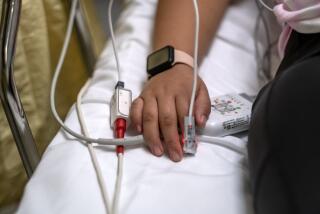Hospitals Fear Jams at New Year’s
- Share via
A worse than usual season for respiratory ailments coupled with a possible hike in traumatic injuries over the millennium holiday could lead to year-end gridlock in the region’s emergency rooms, health care officials warned Monday.
In Los Angeles, some officials said they are particularly worried about demand for services in the central city, where hospital coverage is sparser.
Statewide, hospitals are being squeezed as in years past by a shortage of nurses, particularly in intensive care units. Car accidents, altercations and gunfire on New Year’s Eve may add to the crunch, although many hospitals will be on high alert for the holiday.
“We’re not worried about the computers,” said Virginia Hastings, director of emergency medical services in Los Angeles County. “We’re worried about the partyers.”
Many hospitals in the county have canceled vacations and holidays for their clinical staff in anticipation of increased demand over the New Year’s weekend, said Jim Lott, a spokesman for the Healthcare Assn. of Southern California. Some are drawing heavily on nursing registries--temporary agencies for nurses. Others, such as California Medical Center in downtown Los Angeles, are insisting that everyone from the administrator on down be on duty.
But not all hospitals are taking extraordinary measures.
“I don’t think this New Year’s Eve will be significantly different from any other,” said Dr. Marshall Morgan, chief of emergency medicine at UCLA Medical Center. “Unless the crazies pull off some terrorist incident . . . and we [have a] disaster plan for that.”
Whatever the demand for emergency care, anyone with major injuries will be speeded into the trauma system, officials said. Those with less severe ailments may have to wait longer than usual for attention.
As one official put it, a person with a gunshot wound to the head won’t have any trouble being whisked to an operating room; a person shot in the arm might.
Hastings said paramedic traffic may be delayed somewhat as well, if emergency rooms become so busy that paramedics run into bottlenecks delivering patients to hospitals.
Health care officials statewide and in Southern California hastened to assure the public that they have been preparing for months for possible Y2K computer glitches and unlikely medical disasters. In September, about 425 hospitals in California participated in a drill involving simulated power and phone failures, compromised water supplies, a rash of bullet wounds and women in labor.
For the most part, the test went well, the only major complication being a failure of a new state computer system to display the number of hospital beds available in five counties.
Yet hospitals now face an added challenge with the recent deluge of patients stricken with the flu, respiratory disease and other problems.
On Friday, the problem was so bad that half of Southern California’s 84 public and private acute care hospitals were asking that patients be diverted to other facilities. The hospitals were ordered to find beds for patients anyway and remained seriously strained through the weekend and Monday.
“It’s been miserable,” said Dr. Alan Heilpern, an emergency room physician at St. John’s Health Center in Santa Monica and former president of the county medical association. “We’re all overwhelmed.”
Heilpern said his emergency department was treating 30% more patients than usual this past weekend.
“Patients are spending their entire two- to three-day admission in the emergency room,” he said.
Dr. Brian Johnston, an emergency physician and chairman of the Board of Trustees of the Los Angeles County Medical Assn., said a shortage of both nurses and beds created gridlock in central city emergency rooms by Saturday morning.
“I think we’re all very nervous” about the additional trauma traffic resulting from New Year’s revelry, he said.
Hospital officials emphasized that people should avoid using emergency rooms unless they are seriously ill or injured.
“Most of the people we are seeing are really people who could stay home,” said Sylvia Robledo, public information officer for California Medical Center in downtown Los Angeles.
“Ninety percent of the [visits] are probably avoidable,” she said. Most patients are just as well off consulting their physicians and seeking relief from over-the-counter medications.
Lott said that if any major emergency occurs around New Year’s, the county could draw upon state and federal resources for support, in accordance with established plans. Short of that, he said, hospitals are left with burgeoning patient loads and inevitable uncertainty.
“We haven’t had a millennium event to test us,” he said.
More to Read
Sign up for Essential California
The most important California stories and recommendations in your inbox every morning.
You may occasionally receive promotional content from the Los Angeles Times.













